
Rural school districts in north-central Pennsylvania have been forced to close elementary schools because of aging infrastructure, budget shortfalls, and declining student populations.
Nate Smallwood / For Spotlight PA

Rural school districts in north-central Pennsylvania have been forced to close elementary schools because of aging infrastructure, budget shortfalls, and declining student populations.
Nate Smallwood / For Spotlight PA

Nate Smallwood / For Spotlight PA
Rural school districts in north-central Pennsylvania have been forced to close elementary schools because of aging infrastructure, budget shortfalls, and declining student populations.
This story was produced by the State College regional bureau of Spotlight PA, an independent, nonpartisan newsroom dedicated to investigative and public-service journalism for Pennsylvania.
At least 38 elementary schools in north-central Pennsylvania have closed over the past decade, forcing students and staff to adapt to more crowded schools, longer commutes, and larger class sizes.
Some of the districts hardest hit by these closures, many in shrinking rural areas of the state, cited student population decline as a reason for shutting down schools.
Enrollment at the 55 districts Spotlight PA focused on declined by 11% over the past decade — outpacing a statewide decline of 8%.
But district officials and experts said there are also more universal reasons for these rural closures, from the flight of students from traditional public schools to charters to a lack of state funding.
All but five of the 55 school districts face per-student funding shortfalls, some of which exceed $2,000, according to an analysis by Matthew Kelly, an education professor at Penn State who studies funding policy.
Kelly prepared the analysis as part of a landmark lawsuit that claimed the state is violating its constitution by underfunding poor school districts. Commonwealth Court recently ruled in favor of the challenge, though it did not prescribe a remedy for the issue or direct the governor and legislature to act in a specific way.
When it comes to shutting down schools, officials often don’t have much of a choice, Kelly said. Unforeseen circumstances can leave a district with few alternatives to closures.
In 2012, the Clearfield Area School District Board of Directors voted to close Girard-Goshen Elementary School after it had been temporarily shut down in 2010 because of abnormalities in the roof structure, which put students’ safety at risk, then-district Superintendent Thomas B. Otto said in a letter to the state Department of Education.
Although the school was not particularly old at the time — it was reportedly built in 2002 — it would have cost $1.5 million to repair the roof for the 66 students enrolled there. The superintendent wrote a shortfall in district revenue played a role in the decision to shut down the school.
“I think that’s the position that a lot of rural schools are in,” said Kai Schafft, the director of Penn State’s Center on Rural Education and Communities. “They just don’t have a whole lot of financial wiggle room.”
There are a variety of reasons why these rural districts have shut down schools.
They’ve done so to navigate aging infrastructure, comply with special education requirements, and outfit classrooms with technology, said Matt Kengersky, president of the Punxsutawney Area School District’s board.
But the two major reasons are budget shortfalls and shrinking student populations.
In the 2019-20 school year, public schools in Pennsylvania received about 6.7% of their funding from the federal government, and 38.4% of their funding from the state government. To come up with the rest, school districts rely on property taxes and other local revenue streams. School districts in poorer communities struggle to raise funds because property tax revenue is lower when property values are lower.
The percentage of funding public schools in Pennsylvania receive from the state is among the lowest in the country, according to 2019-20 school data from the National Center for Education Statistics. The states that provide the highest percentages of education funding are Hawaii (90.4%), Vermont (90%), and Washington (70.6%). Among the states that provide the lowest percentages of education funding are Missouri (30.7%), New Hampshire (31.2%), and South Dakota (33.7%).
“The pie is too small,” said Kelly. “It’s not enough money, and then the way that the money that is there is being distributed is still not connected enough to what the actual costs districts are encountering are.”
Education funding has been a problem for many Pennsylvania districts for decades, largely because the state didn’t factor in changes in enrollment or the types of students who attended certain schools when doling out money until fairly recently.
In 2007, a study commissioned by the legislature revealed a $21.63 billion funding shortfall to adequately educate all students. The next year, the General Assembly approved a funding formula that set a standard amount of per-student funding with extra funds provided based on the number of students in poverty, those who didn’t speak English as a first language, and more.
It wasn’t used for long, as then-Republican Gov. Tom Corbett weakened it in 2011 while making major budget cuts. An updated formula followed in 2016 that takes into account the same factors the 2008 formula did, but it is only applied to new state funding — or about 10% of what the state spends on schools.
Poorer school districts are most likely to be affected by a lack of state funding. Kelly’s calculations using 2020-21 data found 277 school districts need at least an additional $2,000-plus per student to meet the state’s benchmark to support student needs.
Five of those districts with significant shortfalls are located in the north-central region and have implemented several recent school closures.
“When districts don’t have a way to generate the funds they need, they will have to make difficult choices like closing schools,” Kelly said. “But after making those choices, it’s not going to fix the larger structural problem there.”
Population loss and the resulting drop in student enrollment are also leading to school closures in north-central Pennsylvania. Census data highlighted by The Inquirer in 2020 shows many of the rural communities that have lost schools have also been losing population.
The increased popularity of charter schools also might have played a role in the uptick in elementary school closures, suggested Schafft.
Charter schools are independently run public schools that receive a portion of funding from school districts for every student that attends, whether brick and mortar or online.
While closing schools can seem like a smart economic decision, communities face hidden costs like increased transit expenses, stunted economic activity, and reduced housing values, said Schafft of Penn State’s Center on Rural Education and Communities.
Elementary school consolidations and closures can mean really young students have to adapt to environments meant for older kids. They might lose resources and hobbies as officials need to allocate more rooms for classes, and they face longer commutes from their rural communities to the more centralized, larger schools in bigger communities.
In 2011, Mifflin County School District closed Highland Park Elementary School and intended to move the students into Indian Valley Middle School. More than 20 people spoke at a public hearing and expressed concerns about potential safety issues for younger students being moved into a school not designed for them — such as lockers and a second floor.
In 2018, Punxsutawney Area School District consolidated all six of its elementary schools and its middle school to create one of the largest elementary schools — more than 1,000 students in the 2021-22 school year, according to state enrollment data — in north-central Pennsylvania.
Dozens of parents spoke at a public hearing and brought up various concerns, like losing access to the arts, particularly band. One parent was concerned consolidation would eliminate band rooms and reduce band staff.
A parent in Mifflin County raised concerns about longer commutes in the 2011 meeting. In a separate interview, a parent of students in the Punxsutawney Area School District said the consolidation has increased her children’s commute times.
Longer bus rides can negatively affect learning outcomes for students that must wake up earlier and get less sleep. They may also drive down attendance rates, according to an article from the Brookings Institution.
But the challenges that local schools face when they close schools extend beyond students’ experiences. These closures can have more widespread and less obvious costs too, Schafft said.
Some teachers and maintenance staff might lose their jobs, and communities without local schools are considered less desirable places to live, which can affect housing values, he said.
Closing school buildings can also lead to blight.
School districts sometimes are able to sell the properties. Mature Resources Area Agency on Aging bought the Girard-Goshen Elementary School, about 20 minutes from Clearfield, in hopes of transforming it into an older adult living community called the “Village of Hope.”
However, the building was in poor condition and had to be torn down, the nonprofit’s Director of Communications Steve Harmic said. Further complicating matters, the land is surrounded by solar panels, lacking the tranquil setting the nonprofit envisioned, Harmic said. The land sits vacant today.
In north-central Pennsylvania, schools have had to make changes to accommodate more students in fewer buildings.
Clearfield Area School District Superintendent Terry Struble said the district has been able to accommodate more students without changing class sizes too drastically, despite consolidation. But the district states in its district-level plans for 2018-21 that “the physical space needs of the elementary school need to be resolved.”

Nate Smallwood / For Spotlight PA
Clearfield Area Elementary School is one of the largest elementary schools in north-central Pennsylvania, with more than 1,000 students.
Clearfield Area Elementary School is one of the biggest in Spotlight PA’s 14-county north-central Pennsylvania coverage region, with more than 1,000 students enrolled in the 2021-22 school year, according to Pennsylvania Department of Education data.
But having these students in one place has had positives as well, Struble said, such as more equitable access to resources. It’s easier for the district to provide for the needs of all the special education students in a single building. Plus, students are able to learn from different teachers through what Struble calls a “round robin.”
Danielle Brody, now a teacher in Saint Marys Area School District, previously worked in the DuBois Area School District and said the DuBois middle school effectively accommodated the fifth-graders who came up from the four closed elementary schools.
“The teachers did a very good job of making sure students understood their expectations,” she said.
The school got creative with using classrooms for multiple purposes. But teachers had the challenge of teaching additional subjects.
Audrey Dobson, a mother of four children in the Punxsutawney Area School District, said her kids did not get the same hands-on learning experience she did when she attended school there. Two of her children attend Punxsutawney Area Elementary School.
Traveling from home to the consolidated elementary school by car takes 10 minutes by car. But that trip becomes an hour when taken by bus.
“It’s a lot of, ‘Here’s your laptop. Here’s your notebook. Here’s your paper.’ It’s not hands-on,” she said. “It lacks the personal [feeling] that they need to get through the day.”
Ashad Hajela is a Report for America corps member and writes about rural affairs for Spotlight PA’s State College regional bureau.

Get insights into WITF’s newsroom and an invitation to join in the pursuit of trustworthy journalism.
The days of journalism’s one-way street of simply producing stories for the public have long been over. Now, it’s time to find better ways to interact with you and ensure we meet your high standards of what a credible media organization should be.